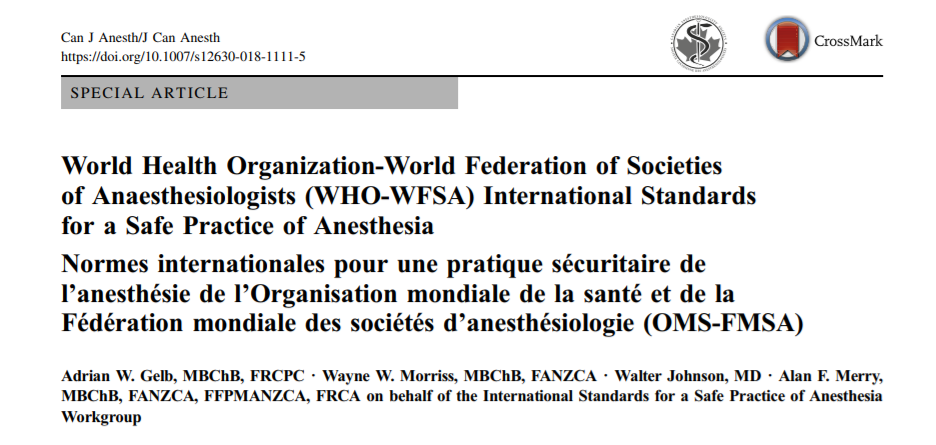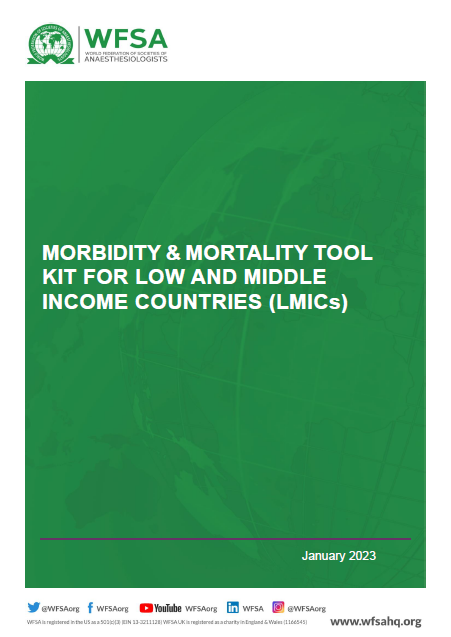Standards, Guidelines & Specifications
WHO-WFSA International Standards for a Safe Practice of Anesthesia
These standards are recommended for anaesthesia professionals throughout the world. They are intended to provide guidance and assistance to anaesthesia professionals, their professional societies, hospital and facility administrators, and governments for improving and maintaining the quality and safety of anaesthesia care. They were adopted by the World Federation of Societies of Anaesthesiologists on the 13th June 1992, and revisions were ratified on 5th March 2008 and on 19th March 2010.
You can also read the WHO-WFSA International Standards for a Safe Practice of Anesthesia in Arabic (available here), Chinese (available here), French (available here) and in Spanish (available here).
Watch WFSA Secretary Professor Adrian Gelb deliver a lecture on ‘The Importance of International Standards’ at the Australian and New Zealand College of Anaesthetists, Annual Scientific Meeting 2018. Professor Gelb’s lecture emphasises that one International Standard for Safe Anaesthesia can work on a global scale independent of provider and location.
The WFSA has also developed a comprehensive Anaesthesia Facility Assessment Tool (AFAT)
This forms part of a range of resources on National Surgical Planning available from the Harvard Program in Global Surgery and Social Change.
WFSA – Minimum capnometer specifications 2021
The WHO-WFSA International Standards for a Safe Practice of Anesthesia list capnography as RECOMMENDED but add the following important note, “Continuous waveform capnography will be HIGHLY RECOMMENDED when appropriately robust and suitably priced devices are available”. (HIGHLY RECOMMENDED is the WHO equivalent of essential / mandatory).
In support of this recommendation, the WFSA has published The World Federation of Societies of Anaesthesiologists Minimum Capnometer Specifications 2021—A Guide for Health Care Decision Makers and the accompanying editorial Instructions for a Highly Relevant Tool in Line with the United Nations Goals for Sustainable Development in the WFSA official journal, Anesthesia & Analgesia.
We recommend reading The global capnography gap: a call to action and Impact of capnography on patient safety in high- and low-income settings: a scoping review which provides a compelling argument in support of capnometry becoming more widely available globally.
Guidelines for tendering for anaesthesia machines
As the supply of electricity and compressed gases varies from location to location the WFSA has developed guidelines for those seeking to tender for and purchase anaesthesia machines. Following ISO standards (which the WFSA helped to develop) this short document and flowchart guides the decision maker to the ISO standard appropriate for their environment.
Mortality and Morbidity Tool Kit
The Mortality and Morbidity Tool Kit is an essential resource for healthcare providers to analyze patient morbidity and mortality events, identify underlying causes, and improve patient care. The Tool Kit provides frontline staff, particularly anaesthesiologists, with an authoritative and adaptable resource to analyze patient morbidity and mortality events and improve patient care.
The tool kit includes open-source techniques, open-access design, and technical and implementation resources to help hospitals implement M&M meetings.
It also includes background reading materials to guide readers on essential topics for advancing patient safety and risk management. Each chapter provides a suggested reading list for deep reflection and further self-learning to support optimal care delivery.







